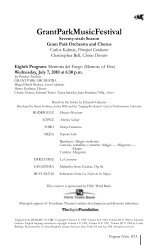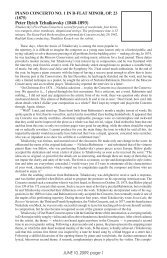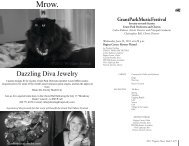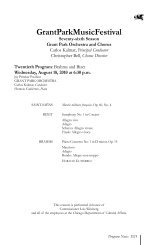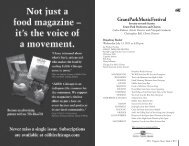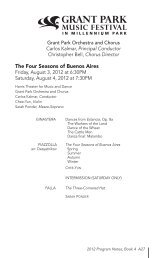rossini's Stabat Mater - The Grant Park Music Festival
rossini's Stabat Mater - The Grant Park Music Festival
rossini's Stabat Mater - The Grant Park Music Festival
You also want an ePaper? Increase the reach of your titles
YUMPU automatically turns print PDFs into web optimized ePapers that Google loves.
as Josquin, Palestrina, Lassus and Haydn, but the outstanding setting of the verses<br />
was considered at that time to be the one that Giovanni Battista Pergolesi made in<br />
1736. After hearing Pergolesi’s work in Naples in 1820, Gioacchino Rossini vowed<br />
never to put himself in competition with it by composing the same text, but in 1831,<br />
he was prompted to change his mind.<br />
In February 1831, Rossini’s friend, patron and financial advisor, Alexandre-Marie<br />
Aguardo, a naturalized Frenchman of Spanish birth, arranged to take the composer<br />
for a visit to his native land. In Spain, Rossini was feted by King, court and public<br />
alike, but he was most warmly welcomed by Aguardo’s friend Don Francisco Varela,<br />
a cleric, a court counselor and a passionate admirer of his music. Varela longed to<br />
have his very own work in the composer’s hand, and suggested the <strong>Stabat</strong> <strong>Mater</strong> as<br />
an appropriate text. Rossini, who had formally retired from composition two years<br />
before with William Tell, at first demurred, but was eventually cajoled by Aguardo<br />
into supplying this ardent request from such a distinguished source. Sometime after<br />
returning to Paris, Rossini completed six movements of his <strong>Stabat</strong> <strong>Mater</strong> before an<br />
attack of lumbago, exacerbated by his chronic problems with gonorrhea, confined him<br />
to bed for an extended period. Giovanni Tadolini, a native of Bologna, a fellow alumni<br />
with Rossini of that city’s conservatory and then conductor of the Théâtre Italien in Paris,<br />
was enlisted to finish the job. On March 26, 1832, the <strong>Stabat</strong> <strong>Mater</strong> was dispatched to<br />
Varela with an appropriately flowery dedication and the stipulation that the score was<br />
not to be sold or published, but with no indication of the dual authorship of the music.<br />
Varela responded by sending Rossini a magnificent gold snuffbox studded with eight<br />
diamonds. (It is unknown what payment Tadolini received.) Varela reserved his new<br />
work for performance until Good Friday of the following year, when it was given by<br />
more than a hundred singers at the chapel of S. Filippo El Real in Madrid.<br />
Rossini thereafter paid little attention to his <strong>Stabat</strong> <strong>Mater</strong> until 1837, when Varela<br />
died. <strong>The</strong> manuscript for the work was purchased at that time from Varela’s estate<br />
by one Oller Chetard, and four years later came into the possession of the Parisian<br />
publisher Antoine Aulagnier. Aulagnier sought Rossini’s permission to issue the work,<br />
but was summarily refused on the grounds that the <strong>Stabat</strong> <strong>Mater</strong> was intended only<br />
for Varela’s use and that it was essentially incomplete in any case. Rossini drew up a<br />
contract assigning the rights for the score to Eugène-Théodore Troupenas, publisher of<br />
his last four operas, and litigation was joined. <strong>The</strong> ensuing legal battle was decided in<br />
favor of Rossini and Troupenas, which made it incumbent upon the composer to finish<br />
the work that he had abandoned to another hand a decade before. Private readings<br />
of the <strong>Stabat</strong> <strong>Mater</strong> were given in October 1841 at the Parisian salons of the Austrian<br />
pianist Henri Herz and the pianist-composer Pierre-Joseph-Guillaume Zimmerman, and<br />
word of this “new” composition by Rossini, his first substantial creation in a dozen years,<br />
began to circulate among the city’s music lovers. <strong>The</strong> brothers Léon and Marie Escudier,<br />
music publishers and long-standing admirers of Rossini’s compositions, arranged a<br />
public performance for January 7, 1842 at the Salle Ventadour, which proved to be a<br />
spectacular success, though the composer could not attend because he was busy in<br />
Bologna directing the affairs of the Liceo <strong>Music</strong>ale. Rossini himself superintended the<br />
first Italian performances of the <strong>Stabat</strong> <strong>Mater</strong>, however, which took place in Bologna<br />
on March 18, 19 and 20. Gaetano Donizetti, whom he was seeking to install on the<br />
Liceo’s faculty, served as conductor. <strong>The</strong> <strong>Stabat</strong> <strong>Mater</strong> again triumphed, as it did all<br />
across Europe and America — it was performed at least a half-dozen times annually<br />
in Paris after 1842, Michael Costa led some 3,000 singers and instrumentalists in its<br />
presentation in following years at the Crystal Palace in London, Rossini was made a<br />
knight in the recently instituted Order of Merit in the Sciences and Arts by King Friedrich<br />
Wilhelm IV of Prussia in 1842 largely because of its reception, and it was given in such<br />
foreign parts as New York, Philadelphia and Boston within months of its premiere. <strong>The</strong><br />
brilliant success of the <strong>Stabat</strong> <strong>Mater</strong> was mitigated for Rossini only by the death of<br />
A38 2012 Program Notes, Book 3<br />
Friday, July 20 and Saturday, July 21, 2012



